 |
 |
|
 |
Zi-jhu Sheng-chun | Falling of Seven Stars | Misty Yan-men | 308 Highland
| Mu-jha Suspension Bridge | King of Ya-Mu, Jhu Yi-Guei | Guang-ming Bridge |
Towering and Green Stone Gate |
| |
 |
Zi-jhu Sheng-chun |
|
| |
Zi-jhu Sheng-chun is located in Guan-ting Village where Er-ren Creek and Ci-sing-yang Canal merge. The small basin formed in the middle resembles a lotus, and thus Feng-shui experts named the place Lotus Cave. Qian-Long 7 (1742) Navy Commander Bi-Da Wu passed by here and heard about the flourishing Zhi-Jhu Temple. Thus he entered the temple and paid his respects. He was in awe of the lotus basin and therefore made a plate that named Zi-jhu Sheng-chun. To this date, this 300-year-old plate is still well maintained. |
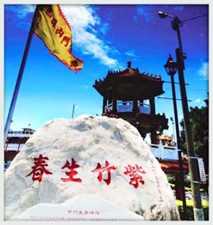 |
|
 |
 |
 |
Falling of Seven Stars |
| |
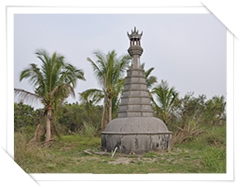 Falling of Seven Stars is located north of Guan-ting Village in Nei-men Township, and is the most widely-spread legend amongst Nei-men town people. It is rumored that there were 7 meteors that fell to Nei-men in ancient times. They formed 7 small heaps of soil and were arranged into a shape that resembles the seven stars of the Big Dipper, which thereby gained the place its name. Over the years, the town people had been protecting these 7 heaps of soil as vital veins of Zhi-Jhu Temple. In the Japanese Colonial Period, there was a high-level Japanese official who wanted to even out the piles to grow sugar cane. But then a series of unexplainable events started to take place, the workers were afraid to start the destruction, the official's family member also suddenly became ill. At the end, they could only surrender to the divine power; the legend of the vital veins of the Seven Stars became even more untouchable. Falling of Seven Stars is located north of Guan-ting Village in Nei-men Township, and is the most widely-spread legend amongst Nei-men town people. It is rumored that there were 7 meteors that fell to Nei-men in ancient times. They formed 7 small heaps of soil and were arranged into a shape that resembles the seven stars of the Big Dipper, which thereby gained the place its name. Over the years, the town people had been protecting these 7 heaps of soil as vital veins of Zhi-Jhu Temple. In the Japanese Colonial Period, there was a high-level Japanese official who wanted to even out the piles to grow sugar cane. But then a series of unexplainable events started to take place, the workers were afraid to start the destruction, the official's family member also suddenly became ill. At the end, they could only surrender to the divine power; the legend of the vital veins of the Seven Stars became even more untouchable.
Today, Zhi-Jhu Temple has built 4-meter high Seven Star Towers separately at the site of these 7 heaps of soil. They are eye-catching and exquisite during the day, and their lights would shine at night echoing the seven stars of the Big Dipper in the sky, forming unique scenery in Nei-men Township. There is Jin-Hu Seafood Restaurant near the Seven Star Towers; visitors can enjoy gourmet food while admiring the rare beautiful scenery of the Seven Star Towers pointing coincidentally with the seven stars in the sky. |
|
 |
 |
 |
Misty Yan-men |
| |
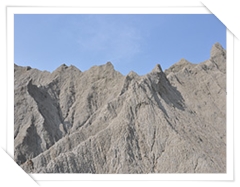 Misty Yan-men has been listed as one of the Eight Scenic Spots of Taiyang during the Qing Dynasty. Misty Yan-men has been listed as one of the Eight Scenic Spots of Taiyang during the Qing Dynasty.
The local rough terrain is formed by mud rock, and years of wind and rain erosion created mountains of different shapes along with steep cliffs. With Er-ren Creek flowing through, arrays of mountains are aligned just like a group of flying swallows.
The contrasting views of dawn and dusk at Misty Yan-men are varied on sunny and rainy days; it is especially elegant amidst the misty fog. As you look closer, the little stone piles above the mud rock are just like puppets who are climbing towards the top. Therefore, the locals also call the scenery “puppets climbing up the sky”. |
|
 |
 |
 |
308 Highland |
| |
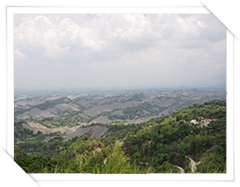 308 Highland The name comes from its altitude at 308 meters. The highland is located at the intersection of Nei-men Township, and Zuo-jhen Township and Long-ci Township of Tainan County, so one can step on three townships at the same time.Falling of Seven Stars 308 Highland The name comes from its altitude at 308 meters. The highland is located at the intersection of Nei-men Township, and Zuo-jhen Township and Long-ci Township of Tainan County, so one can step on three townships at the same time.Falling of Seven Stars
308 Highland is the summit of nearby mountains with broad overlooking view. Visitors are able to have close looks at the rough terrains while overlooking Jia-Nan Plain and Tainan seashore from dawn to dusk. The view here is gorgeous and changing every second. |
|
 |
 |
 |
Mu-jha Suspension Bridge |
| |
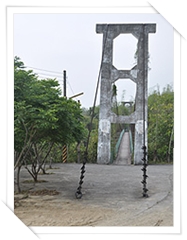 Mu-jha Suspension Bridge Mu-jha Suspension Bridge that is located at halfway up a mountain near Mu-jha Church is a major characteristic of Shih-cuo Hiking Trail. The bridge is about 200-meters long; and when one views it from afar the bridge is just like a silver thread tied up to the mountains on the two ends. Standing on the bridge, visitors would have a broad view of the beautiful scenery. And under the bridge, there is a stone well run through by tens of thousands of years of water droplets. On the other hand, there are also stone houses formed by huge sizes of stones at the Shih-cuo Hiking Trail. Along with the clock tower where the legend Widow Clock took place, the trail possesses tranquil natural landscape. It takes about half an day round trip to the bridge. Mu-jha Suspension Bridge Mu-jha Suspension Bridge that is located at halfway up a mountain near Mu-jha Church is a major characteristic of Shih-cuo Hiking Trail. The bridge is about 200-meters long; and when one views it from afar the bridge is just like a silver thread tied up to the mountains on the two ends. Standing on the bridge, visitors would have a broad view of the beautiful scenery. And under the bridge, there is a stone well run through by tens of thousands of years of water droplets. On the other hand, there are also stone houses formed by huge sizes of stones at the Shih-cuo Hiking Trail. Along with the clock tower where the legend Widow Clock took place, the trail possesses tranquil natural landscape. It takes about half an day round trip to the bridge. |
|
 |
 |
 |
King of Ya-Mu, Jhu Yi-Guei |
| |
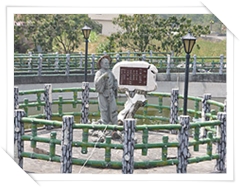 King of Ya-Mu, Jhu Yi-Guei can be considered the most famous figure in Nei-men, because he is Taiwan's first emperor. It is believed that King of Ya-Mu was outgoing and hospitable. Even though he made a living from growing ducks, he possessed amazing charisma as he was not only capable of directing the line up of the ducks, each female duck was able to produce eggs that have two egg yolks. King of Ya-Mu, Jhu Yi-Guei can be considered the most famous figure in Nei-men, because he is Taiwan's first emperor. It is believed that King of Ya-Mu was outgoing and hospitable. Even though he made a living from growing ducks, he possessed amazing charisma as he was not only capable of directing the line up of the ducks, each female duck was able to produce eggs that have two egg yolks.
In the beginning of the Qing Dynasty, Taiwanese government officials were corrupted and bending the laws. Jhu Yi-Guei, who had the same surname as Ming Dynasty Emperor and had also served in Koxinga's army, led the angry residents in a revolution. Soon, Jhu took control of Taiwan, established a new country, and declared himself the new emperor. Unfortunately, the later internal conflict between Min-nan and Cantonese people eventually created the opportunity for the Qing soldiers to capture and kill Jhu.
The hero image of Jhu Yi-Guei is stayed forever in everyone's heart as Nei-men town people built temples in his remembrance. Today, Ya-Mu Temple and the original Xing-An Temple have been included in a comprehensive planning project. Beautiful parks are planned to be built in front of the temples, providing residents and tourists a great place to pay their tributes to a hero as well as a recreational space. Also, there is a water well that Jhu Yi-Guei had drank from and had used to raise ducks. It is rumored that tea, duck eggs and duck cuisine made from using water from this well are especially sweet and tender. |
|
 |
 |
 |
Guang-ming Bridge |
| |
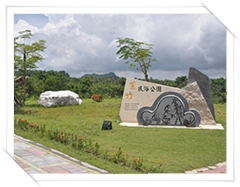 Guang-ming Bridge is located in front of Zhi-jhu Temple in Nei-men and is a scenic spot newly developed for Nei-men. The construction started in 2005 and was finished in 2007. Guang-Ming Bridge crosses over Er-ren Creek with a total length of 195 meters. The design integrates bamboos and local cultural image. Guang-ming Bridge is located in front of Zhi-jhu Temple in Nei-men and is a scenic spot newly developed for Nei-men. The construction started in 2005 and was finished in 2007. Guang-Ming Bridge crosses over Er-ren Creek with a total length of 195 meters. The design integrates bamboos and local cultural image.
The bridge connects two of the Eight Scenic Spots of old Nei-men, namely Zhi-jhu Sheng-chun and Standing General. Visitors can go to Zhi-jhu Temple via the bridge and directly enter General Mountain Natural Park Area and mountain surrounding trail. Visitors can also ask for blessing cards from Zhi-jhu Temple, write their wishes on the cards, and tie them up on Guang-ming Bridge, so that they could receive Guanyin's blessings and walk towards the positive. |
|
 |
 |
 |
Towering and Green Stone Gate |
| |
 Towering and Green Stone Gate is a volcanic rock that goes in the south-north direction. It resembles a stone gate that is cut through by Dong-men Creek. Towering and Green Stone Gate is a volcanic rock that goes in the south-north direction. It resembles a stone gate that is cut through by Dong-men Creek.
According to the stories passed down by local elderly, after the Jhu Yi-Guei incident, the Qing government ordered all Nei-men people to move out of the town. Worried that local residents might return one day, the government ordered the key passageway or the location of today's Stone Gate be filled up by stones. The name of Stone Gate was thus born. Today, Stone Gate is surrounded by myriad of green bamboos, just like the image of dazzling bamboo woods in the movie Crouching Tiger, Hidden Dragon where the main characters showed off their swift martial arts moves. |
|
 |
|
 |
 |
 |
|